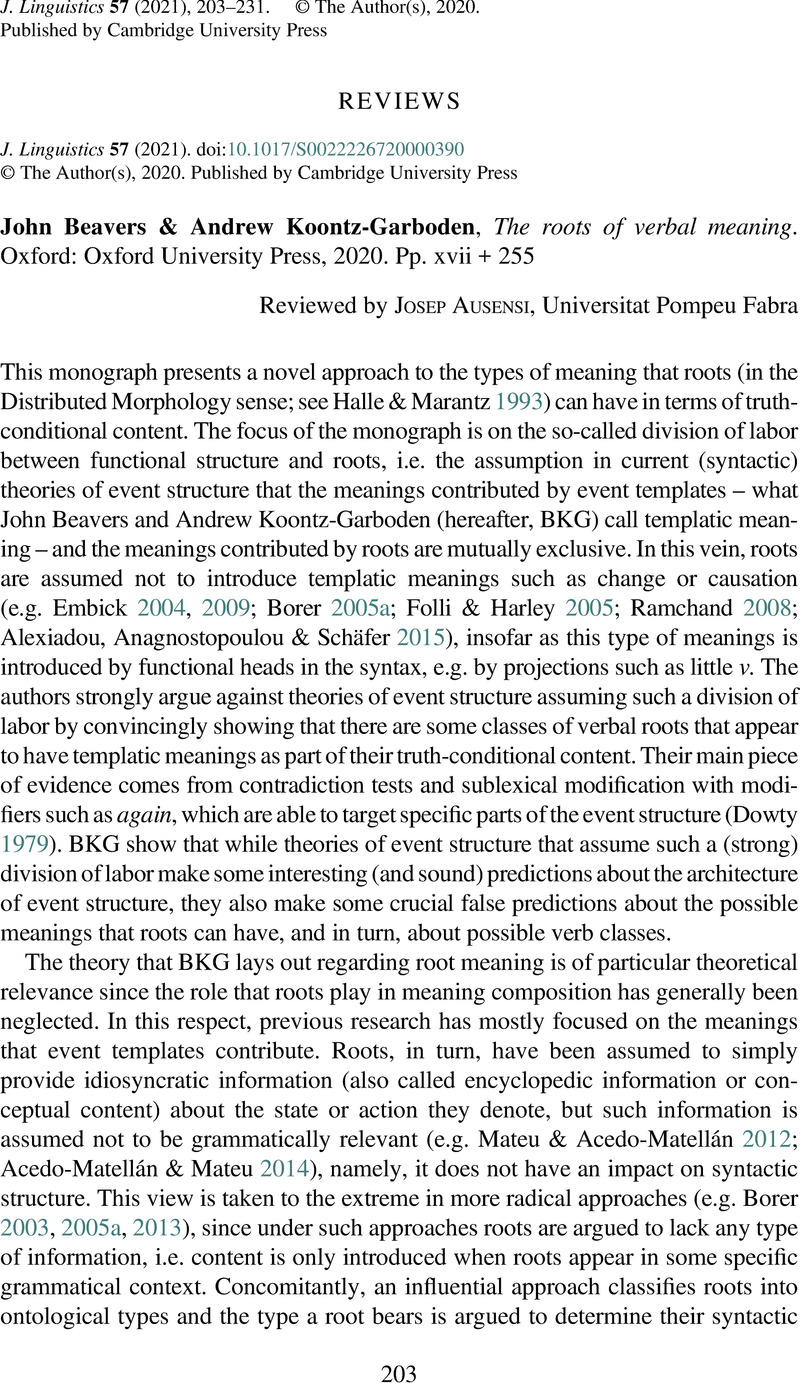No CrossRef data available.
Article contents
Beavers John and Andrew Koontz-Garboden, The Roots of Verbal Meaning. Oxford: Oxford University Press, 2020. Pp. xvii + 255
Review products
Beavers John and Andrew Koontz-Garboden, The Roots of Verbal Meaning. Oxford: Oxford University Press, 2020. Pp. xvii + 255
Published online by Cambridge University Press: 07 December 2020
Abstract
An abstract is not available for this content so a preview has been provided. Please use the Get access link above for information on how to access this content.

- Type
- Reviews
- Information
- Copyright
- © The Author(s), 2020. Published by Cambridge University Press
References
REFERENCES
Acedo-Matellán, Víctor & Mateu, Jaume. 2014. From syntax to roots: A syntactic approach to root interpretation. In Alexiadou, Artemis, Borer, Hagit & Schäfer, Florian (eds.), The syntax of roots and the roots of syntax, 259–281. Oxford: Oxford University Press.Google Scholar
Alexiadou, Artemis, Anagnostopoulou, Elena & Schäfer, Florian. 2006. The properties of anticausatives crosslinguistically. In Frascarelli, Mara (ed.), Phases of interpretation, 187–211. Berlin: De Gruyter Mouton.CrossRefGoogle Scholar
Alexiadou, Artemis, Anagnostopoulou, Elena & Schäfer, Florian. 2015. External arguments in transitivity alternations: A layering approach. Oxford: Oxford University Press.CrossRefGoogle Scholar
Beavers, John. 2011. An aspectual analysis of ditransitive verbs of caused possession in English. Journal of Semantics 28, 1–54.CrossRefGoogle Scholar
Beavers, John & Koontz-Garboden, Andrew. 2020. The Roots of Verbal Meaning. Oxford: Oxford University Press.CrossRefGoogle Scholar
Beck, Sigrid & Johnson, Kyle. 2004. Double objects again. Linguistic Inquiry 35.1, 97–123.CrossRefGoogle Scholar
Beck, Sigrid & Snyder, William. 2001. The resultative parameter and restitutive again. In Sternefeld, Wolfgang & Féry, Caroline (eds.), Audiatur vox sapientiae: A Festschrift for Arnim on Stechow, 48–69. Berlin: Akademia Verlag.Google Scholar
Borer, Hagit. 2003. Exo-skeletal vs. endo-skeletal explanations: Syntactic projections and the lexicon. In Moore, John & Polinsky, Maria (eds.), Explanation in linguistic theory, 31–67. Standford: CSLI Publications.Google Scholar
Borer, Hagit. 2005a. Structuring sense: In name only, vol. 1. Oxford: Oxford University Press.Google Scholar
Borer, Hagit. 2005b. Structuring sense: The normal course of events, vol. 2. Oxford: Oxford University Press.CrossRefGoogle Scholar
Borer, Hagit. 2013. Structuring sense: Taking form. Oxford: Oxford University Press.CrossRefGoogle Scholar
D’Alessandro, Roberta, Franco, Irene & Gallego, Ángel J. (eds.). 2017. The verbal domain. Oxford: Oxford University Press.CrossRefGoogle Scholar
Dowty, David. 1979. Word meaning and montague grammar. Dordrecht: D. Reidel Publishing.CrossRefGoogle Scholar
Embick, David. 2004. On the structure of resultative participles in English. Linguistic Inquiry 35.3, 355–392.CrossRefGoogle Scholar
Embick, David. 2009. Roots, states, stative passives. Presented at the 2009 Roots Workshop, University of Stuttgart.Google Scholar
Fillmore, Charles. 1968. The case for case. In Bach, Emmond & Harms, Robert T (eds.), Universals in linguistic theory, 1–90. New York: Holt.Google Scholar
Fillmore, Charles. 1970. The grammar of hitting and breaking. In Jacobs, Roderick A. & Rosenbaum, Peter (eds.), Readings in English transformational grammar, 120–133. Waltham, MA: Ginn.Google Scholar
Folli, Raffaella & Harley, Heidi. 2005. Flavors of v. In Kempchinsky, Paula Marie & Slabakova, Roumyana (eds.), Aspectual inquiries, 99–120. Dordrecht: Springer.Google Scholar
Goldberg, Adele. 1995. Constructions: A construction grammar approach to argument structure. Chicago: University of Chicago Press.Google Scholar
Halle, Morris & Marantz, Alec. 1993. Distributed morphology and the pieces of inflection. In Hale, Kenneth & Keyser, Samuel Jay (eds.), The view from building 20, 111–176. Cambridge, MA: MIT Press.Google Scholar
Harley, Heidi. 2003. Possession and the double object construction. In Pica, Pierre & Rooryck, Johany (eds.), Linguistic variation yearbook 2, 31–70. Amsterdam: John Benjamins.Google Scholar
Harley, Heidi & Noyer, Rolf. 2000. Formal versus encyclopedic properties of vocabulary: Evidence from nominalizations. In Peters, Bert (ed.), The lexicon-encyclopedia interface, 349–374. Amsterdam: Elsevier Press.Google Scholar
Jackendoff, Ray. 1972. Semantic interpretation in generative grammar. Cambridge, MA: MIT Press.Google Scholar
Lakoff, George. 1965. On the nature of syntactic irregularity. Dissertation, Indiana University, Bloomington.Google Scholar
Marantz, Alec. 1997. No escape from syntax: Don’t try morphological analysis in the privacy of your own lexicon. University of Pennsylvania Working Papers in Linguistics, 4.2, 201–225.Google Scholar
Marantz, Alec. 2007. Restitutive re-, and the first phase syntax/semantics of the VP. Presented at the University of Maryland.Google Scholar
Marantz, Alec. 2009. Roots, re–, and affected agents: can roots pull the agent under little v. Presented at the 2009 Roots Workshop, University of Stuttgart.Google Scholar
Mateu, Jaume & Acedo-Matellán, Víctor. 2012. The Manner/Result Complementarity revisited: A syntactic approach. In Cuervo, M. Cristina & Roberge, Yves (eds.), The end of argument structure? Syntax and semantics, 209–228. New York: Academic Press.CrossRefGoogle Scholar
Pinker, Steven. 1989. Learnability and cognition: The acquisition of argument structure. Cambridge, MA: MIT Press.Google Scholar
Ramchand, Gillian. 2008. Verb meaning and the lexicon. Cambridge: Cambridge University Press.Google Scholar
Rappaport Hovav, Malka. 2008. Lexicalized meaning and the internal structure of events. In Rothstein, Susan (ed.), Theoretical and crosslinguistic approaches to the semantics of aspect, 13–42. Amsterdam: John Benjamins.CrossRefGoogle Scholar
Rappaport Hovav, Malka & Levin, Beth. 1998. Building verb meanings. In Butt, Miriam & Geuder, Wilhelm (eds.), The projection of arguments: Lexical and compositional factors, 97–134. Stanford, CA: CSLI Publications.Google Scholar
Rappaport Hovav, Malka & Levin, Beth. 2008. The English dative alternation: A case for verb sensitivity. Journal of Linguistics 44, 129–167.CrossRefGoogle Scholar
Rappaport Hovav, Malka & Levin, Beth. 2010. Reflections on Manner/Result Complementarity. In Malka, Rappaport Hovav, Doron, Edit & Sichel, Ivy (eds.), Syntax, lexical semantics, and event structure, 21–38. Oxford: Oxford University Press.CrossRefGoogle Scholar
Von Stechow, Arnim. 1995. Lexical decomposition in syntax. In Egli, Urse, Pause, Peter E., Schwarze, Christoph, von Stechow, Armin & Wienold, Götz (eds.), Lexical knowledge in the organization of language, 81–118. Amsterdam: John Benjamins.CrossRefGoogle Scholar
Von Stechow, Arnim. 1996. The different readings of wieder ‘again’: A structural account. Journal of Semantics 13.2, 87–138.CrossRefGoogle Scholar





